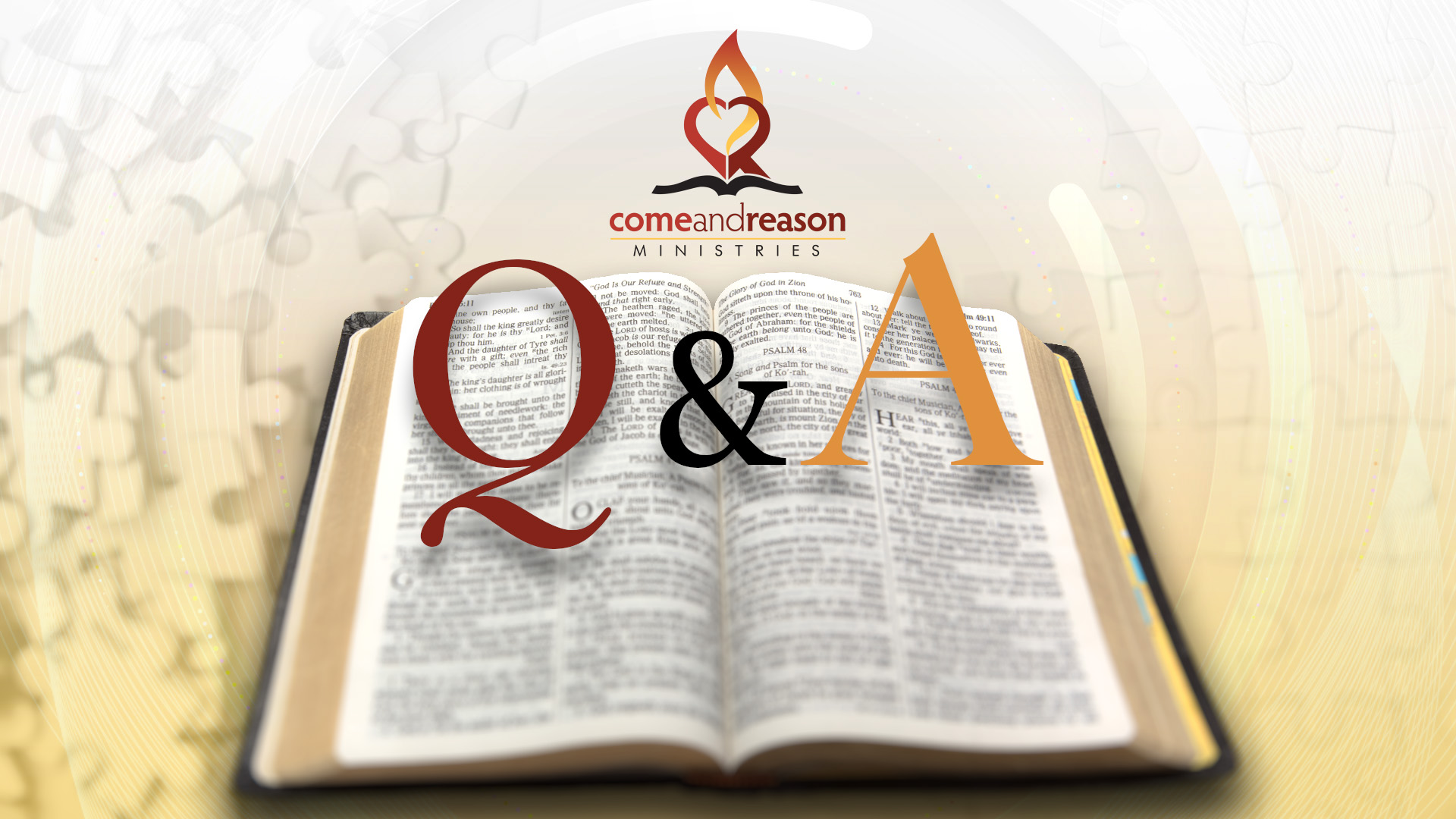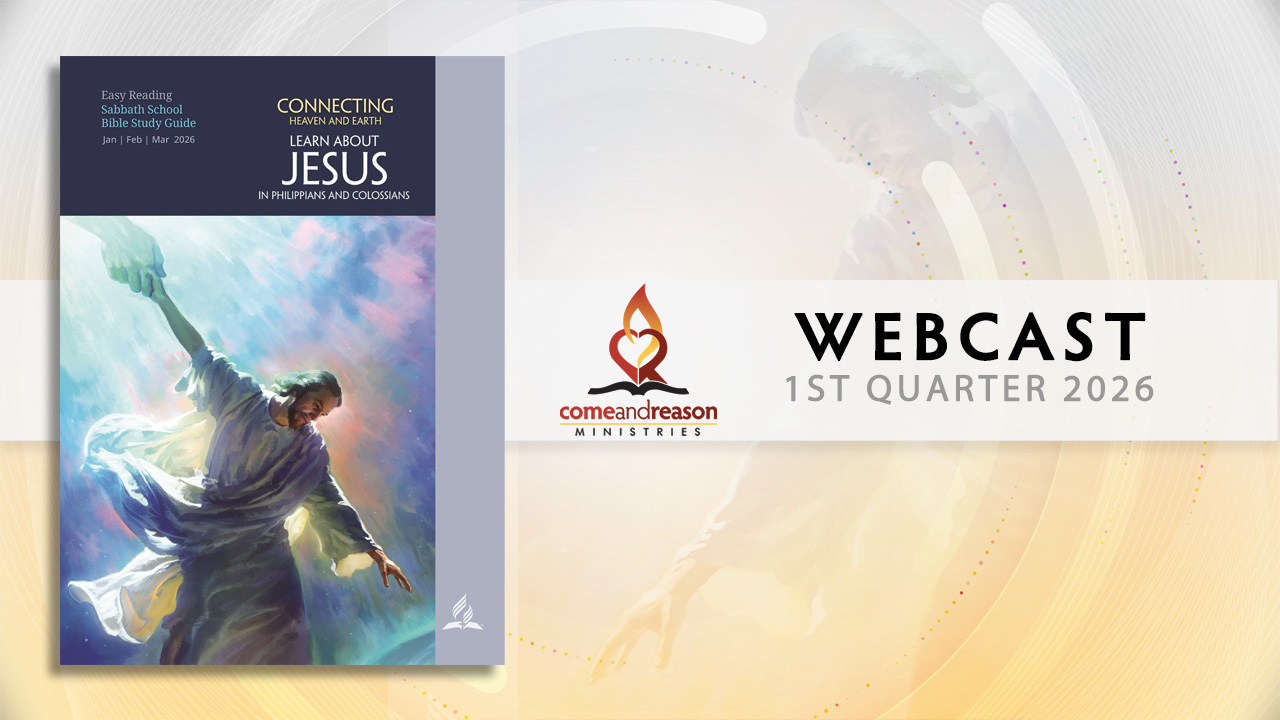It has become apparent that those who have never participated in the Come and Reason Bible Study (BSC) class have false concepts of what we (and others who value a healing model) teach and believe.
Rather than seeking to understand our position, many who disagree with us falsely label us as believing in the Moral Influence Theory (MIT) and then dismiss us out of hand. This article seeks to shed light on this situation by clearly articulating the ideas and concepts that are discussed in Come and Reason SS class. Since the subject of the atonement has often been at the heart of this debate, I have used the term ŌĆ£Healing Substitution ModelŌĆØ (HSM) in this article as an attempt to clarify some misconceptions.
Within a few hundred years after ChristŌĆÖs ascension, the Christian church was corrupted by pagan influences. The Reformation has gradually eliminated pagan concepts from Christianity. It is our hope and prayer that the… church will carry the Reformation forward and take the final message of GodŌĆÖs loving character to the world.
To such an end, we offer what we believe to be a next step in completing the Reformation and ushering in the Second Coming of Christ. We claim no corner on truth. Neither do we believe that we possess the ŌĆ£final wordŌĆØ on truth.┬Ā Rather, in the best Seventh-day Adventist tradition, we believe that truth is progressive and ever unfolding and we eagerly invite our brothers and sisters in Christ to assist us in further developing, refining and purifying this message. (COL 128.1). All to the glory of God, may He be praised!
Contrary to what some erroneously allege, we believe the MIT inadequately explains GodŌĆÖs plan of Salvation. The HSM recognizes sin as a terminal condition, a condition out of harmony with God, His law and, therefore, incompatible with life and thus requires divine remedy. The MIT only provides evidence refuting SatanŌĆÖs lies in order to restore the terminal sinner to trust in God, but leaves the sinner terminal, dying in sin. In other words, MIT provides no remedy.
Similarly, we also believe the Penal Substitution Model (PSM) is laden with pagan ideology from the Dark Ages.┬Ā The PSM shifts the sin problem away from the sinnerŌĆÖs terminal condition, which is in need of healing, to an offended and angry God who needs appeasing.
We believe the next pagan misconception to be removed from our theological understanding is the angry/wrathful God construct. In this view, God (or His law) requires payment or appeasement for sin in order to vindicate His justice. As a result, He inflicts pain and suffering upon his unrepentant children as punishment for sin.
While HSM retains the essential elements of ChristŌĆÖs substitutionary role, it eliminates the pagan belief that God must be appeased by the blood of His Son or that God is the source of death and will one day punish sin by inflicting pain on His unrepentant children until they die. The result of eliminating that belief is that one is left with a clearer knowledge of God.
The importance of GodŌĆÖs character cannot be overstated. Mankind fell when they first believed SatanŌĆÖs lies about God. Ellen White wrote:
It is the darkness of misapprehension of God that is enshrouding the world. Men are losing their knowledge of His character. It has been misunderstood and misinterpreted. At this time a message from God is to be proclaimed, a message illuminating in its influence and saving in its power. His character is to be made known. Into the darkness of the world is to be shed the light of His glory, the light of His goodness, mercy and truthŌĆ”The last rays of merciful light, the last message of mercy to be given to the world, is the revelation of His character of love.ŌĆØ┬Ā Christ’s Object Lessons, p.415
The central pillar of Scripture, with which all doctrines must align, is the truth about GodŌĆÖs character of love as manifested through Jesus Christ (Hebrews 1:3). If any doctrine undermines the truth about God, as revealed in Christ, it is misplaced, misunderstood, misaligned or simply wrong. (John 17:3; 2Corinthians 10:3-5; 5T 738.2; GC88 536.2; RH, November 17, 1891 par. 5, 6; ST, January 20, 1890).
The HSM uses an evidence-based integrative approach (or this blog) to Bible study, recognizes the Bible as authoritative (RH, October 9, 1883 par. 13, ED 190), and seeks to demolish ŌĆ£everything which sets itself up against the knowledge of GodŌĆØ (2Cor 10:5) because only in the knowledge of God is there ŌĆ£life eternalŌĆØ (John 17:3).┬Ā When the knowledge of God is rejected, the mind becomes darkened, futile and depraved. (Romans 1:21-22).
The following is a select overview of major points of the HSM (each point in bold below is a link to a PDF document that extensively expands the topic with Biblical and Spirit Of Prophecy support):
The War Between God and Satan:
There is a war over ideas, concepts and beliefs centering on the character of God (Rev 12:7). This war began in heaven when Lucifer told lies about God. The war was subsequently spread to earth by those same lies, and continues today. We use the weapons of truth, love and freedom to war against ŌĆ£everything that sets itself up against the knowledge of God and take captive every thought to Jesus ChristŌĆØ (2Corinthians 10:5). (ST, December 22, 1914 par. 4; PP 68.2; DA 19, 20, 758; ST, 5T 738.1, 2; GC88 536.2; TMK 338.4).
GodŌĆÖs Character:
ŌĆ£God is love and love is not self-seekingŌĆØ (1John 4:8, 1Corinthians 13:5). GodŌĆÖs character of love is completely expressed in the life of Jesus (Hebrews 1:3). Every attribute of God ŌĆō His justice, grace, and even His wrath ŌĆō is an expression of His character of love. God is not arbitrary, but does everything for a reason and with a purpose for the good of all. (TMK 338, DA19).
GodŌĆÖs Law:
GodŌĆÖs law is the law of love, which is the law of life. The law of love cannot be arbitrary, created, enacted, or legislated. GodŌĆÖs law of love originates in the heart and character of God and, thus, has no beginning point and no ending point. It is immutable and can never be changed. GodŌĆÖs law of love is the design template for life. All life is constructed to exist only in perfect harmony with this law. Deviations will bring the natural results of pain, suffering, and death, unless remedied by God Himself. (Romans 13:10; Galatians 5:14; James 2:8; Matthew 12:37-40 PP 33; GC 678.3; COL 258; GC 493; RC 46; DA 21;SR 145; SR 145.3; SR 146.1; PP 364.2; MB 109.2).
GodŌĆÖs Methods:
While Satan loves to use lies and force to advance his agenda (John 8:44; Job 1 & 2), God uses truth, love, freedom, evidence, reason, openness, and humility. God does not use His power to coerce, because what God really wants ŌĆō trust and love ŌĆō cannot be compelled.┬Ā Trust and love cannot be commanded but can only exist in an atmosphere of genuine freedom. While there have been times that God has acted forcefully in cases of emergency in order to preserve a knowledge of who He is, these methods were never His first choice. And God has never tried to force an individual to love Him. (1Corinthians 13:4-7; John 4:23, 24, 8:32, 14:16,17; Ephesians 4:15; Isaiah 1:18; Romans 14:5; Hebrews 5:14; Philippians 2:5-8; Zechariah 4:6; DA 759.1; GC 36.1, 493.2).
Sin:
Sin is ŌĆ£lawlessness,ŌĆØ that is, living outside the law of love, and violates the design template for life. GodŌĆÖs nature is to give (Matt. 5:45, 7:11, 20:28). Sin is selfishness, a condition of the heart/mind which leads to symptoms we call ŌĆ£sins.ŌĆØ┬Ā Sin is, therefore, a deviation, a twisting, of the construction protocols under which life is designed to operate. (1John 3:4; Matt 5:27, 28, 12:34,35; James 4:17; Romans 7:23, 8:7,8; RH, January 5, 1886 par. 8; WB, September 9, 1902 par. 3; GC88 492.2)
Forgiveness:
Forgiveness originates in the heart of God and is an expression of His character of love. GodŌĆÖs attitude is always one of forgiveness. But redemptive forgiveness includes more than GodŌĆÖs personal pardon of our sin. It involves actual reclaiming from sin. To experience forgiveness necessitates a transforming change in the believer, and this necessitated the death of Christ, ŌĆ£for without the shedding of blood there is no forgiveness of [remission ŌĆō reclaiming from] sinŌĆØ (Heb 9:22, MB 114.1).
Substitution:
Christ is our substitute. He became human and took sinful mankindŌĆÖs position. He took our terminal condition upon Himself. He ŌĆ£became sin who knew no sin,ŌĆØ in order to cure mankind from sinfulness. Though sinless, Christ died when He experienced the sense of darkness of God-forsakeness, crying, ŌĆ£Why have you forsaken me?ŌĆØ At the cross, He experienced the consequences of sin much like unhealable sinners will in the end.┬Ā In ChristŌĆÖs human brain, love overcame the temptation to save self (selfishness), thereby destroying the carnal nature, perfectly restoring GodŌĆÖs law of love back into the human species, thus restoring unity between the human species and God. (2Corinthians 5:21; 1Peter 2:24; Isaiah 53:4; Hebrews 4:15; James 1:13, 14; Luke 22:41-44; 3SM 129.3; Con 17, 18; GCB February 25, 1895 par. 6; DA 762.2)
Penalty for Sin (aka wages of sin):
Eternal death (non-existence), experienced by the unrepentant after the Great White throne judgment.
Punishment for Sin:
Punishment is the natural consequence that unremedied sin brings upon the sinner in this life and in the Final Judgment, where each person suffers in the end according to his deeds. Christ, in our place, experienced this mental agony (punishment) for sin during the fractured unity with His Father (“… why have you forsaken Me?”) prior to His actual death, when He ŌĆ£became sin who knew no sin.ŌĆØ
GodŌĆÖs Wrath:
GodŌĆÖs wrath is not like human vengeance.┬Ā┬Ā Because God desires only the service of love, He can never force anyone to live out His law against their will. Thus, GodŌĆÖs wrath is His ultimate and final gift of love for those who refuse His cure. GodŌĆÖs wrath is His abandoning, forsaking, giving up, and ultimately letting people go in response to the choices that they have made.┬Ā As a result, the sinner is allowed to reap what he has freely chosen ŌĆō the suffering of unremedied sin, which culminates in eternal non-existence. (Deuteronomy 31:17, 32:22,23, 32:29,30; Jeremiah 21:5,6,9-10,14; Hosea 5:14,15; Romans 1:18,19,22-26, 4:25;┬Ā Manuscript Release┬Ā vol. 14, p. 3; RH, September 17, 1901 par. 7; RH, September 17, 1901 par. 8).
Atonement:
The Atonement is the complete restoration of unity between God and sinful humanity achieved by Jesus Christ. Jesus achieved humanityŌĆÖs restored unity with God by revealing the truth about God to restore us to trust AND by restoring GodŌĆÖs law of love into humanity through His victorious life while He simultaneously destroyed the carnal nature that He assumed when He became human. He perfected human character, thereby restoring the human species back to the image of God as designed in Eden. The human race was brought back to perfection in the individual person of Jesus Christ and Christ once ŌĆ£made perfect became the source of salvation for all who obey himŌĆØ (Hebrews 5:8).┬Ā The completion of atonement occurs when the universe is again at-one with God. (John 17:11,20-23; Letter 406, 1906;┬Ā 7ABC 464.2, 472.5; RH, September 2, 1890 par. 7; The Home Missionary, April, 1893; ST, March 26, 1894 par. 5; WB September 9, 1902 par. 4; MB 114.1)
The Purpose of ChristŌĆÖs Death:
- To reveal truth which destroys lies and wins us to trust (Colossians 1:20);
- To destroy the devil (Hebrews 2:14);
- To destroy the carnal nature/death (2Timothy 1:10);
- To destroy the devilŌĆÖs work, by restoring GodŌĆÖs law of love back into humanity and thus restoring GodŌĆÖs character in man (1John 3:8, LHU 48).
Intercession:
Intercession is not something that Jesus does to appease an angry Father. Rather, it is the work of the entire GodheadŌĆöFather, Son, and Holy Spirit ŌĆō all working together in perfect union to intercede against Satan and sin in order to save mankind and secure peace and harmony throughout the universe. They intercede by:
- Holding in check Satanic power and agencies;
- Placing a desire for good in the human heart/mind, a longing for redemption and countering the work of Satanic forces;
- Intervening in the natural result of sinfulness through Christ, who partook of our humanity and overcame sinfulness and restored righteousness, linking fallen humanity back into unity with divinity.
- Christ, being the conduit or avenue of GodŌĆÖs love, truth and grace to His creation, thereby bringing God into the closest possibly communion with His creation.
All members of the Godhead are unified in this mission and work together to achieve these goals. (Genesis 3:15; Exodus 23:20; Job 1:9, 10; Revelation 7:1; John 16:26-29; Zechariah 3:1-4; Romans 8:26, 31-34; ST, July 11, 1895 par. 5; UL 20.3,4; MYP 253.3, 254.1)
Justice:
Justice means doing what is right, what is in complete harmony with GodŌĆÖs law of love. The predominant context of GodŌĆÖs justice in the Bible describes making things right by pouring out loving compassion on those who have been unfairly treated ŌĆō the poor, widow, and outcasts of society. GodŌĆÖs justice is the perfect outflow of GodŌĆÖs benevolent love, no deviations from GodŌĆÖs law, no bending, or twisting around GodŌĆÖs law.┬Ā It is exact conformity with GodŌĆÖs law of other-centered love. For salvation, justice requires perfection of character, perfect harmony with the law of life. Christ justly achieved this perfect character in His human form and in His human brain and, in so doing, God is just in offering ChristŌĆÖs perfect life to all who are willing to trust Him.
GodŌĆÖs justice also includes the reality that those who reject His healing will reap the full weight of suffering and the ultimate and final death that unremedied sin brings.┬Ā (Psalms 82:3; IS 1:16, 17; Jeremiah 21:12; Micah 6:6-8; GC 541.2-543.1).
Justification:
Is not a legal status. Instead it simply means being set right with God. Christ, as our substitute, took defective humanity upon Himself and in His person (human brain) destroyed the carnal nature, perfectly living out the law of love and developed a perfect human character. Therefore, the human race (species) was set right (justified) with God in the person of Jesus Christ. Through this achievement (a free gift), ChristŌĆÖs perfect character is now offered to all mankind. Each individual person is ŌĆ£justifiedŌĆØ (set right) when he is won back to trust by the truth Jesus revealed. In this mindset of trust, they experience the indwelling of the Holy Spirit who ŌĆ£sanctifiesŌĆØ them by transfusing ChristŌĆÖs character into the believer. (Psalms 40:6; Isaiah 53:4, 5; 2Corinthians 5:21; 1Peter 2:24; Hebrews 2:10, 5:9, 8:10; John 16:13-15; ST, January 20, 1890 par. 6; COL 311.4; TMK 78.4, 206; AG 96.4; OHC 364.2).
The law requires righteousness — a righteous life, a perfect character; and this man has not to give. He cannot meet the claims of God’s holy law. But Christ, coming to the earth as man, lived a holy life, and developed a perfect character. These He offers as a free gift to all who will receive them. His life stands for the life of men. Thus they have remission of sins that are past, through the forbearance of God. More than this, Christ imbues men with the attributes of God. He builds up the human character after the similitude of the divine character, a goodly fabric of spiritual strength and beauty. Thus the very righteousness of the law is fulfilled in the believer in Christ. God can “be just, and the justifier of him which believeth in Jesus.” Rom. 3:26. — Desire of Ages, pg 762
- We judge God to be trustworthy and reject the lies of Satan (Romans 3:4), or not. Our judgment of God determines whether we trust Him and thereby determines whether we are healed from sin or die from sin;
- Heavenly beings judge God to be trustworthy in His dealings with Satan and sinful mankind;
- At the Great White Throne Judgment, every man faces his own character/condition/record and suffers the punishment of unhealed sin;
- GodŌĆÖs judgment regarding sin is not an arbitrary declaration that causes something to suddenly become a sin.┬Ā It’s an affirmation of the obvious:┬Ā Sin is a deviation from the law of love. GodŌĆÖs judgment simply affirms the reality that the sinner is ultimately, by his own choice, beyond GodŌĆÖs healing.
Final End of Sin and Sinners:
As God unveils His life giving glory, the fire of His presence of truth and love come out from Him. The wicked and righteous are washed in this life-giving glory. The righteous are renewed by this glory.┬Ā But the wicked, whose minds have been ruined because of their belief in SatanŌĆÖs lies, and who have chosen to develop and solidify their characters of selfishness, suffer torturous mental agony according to the level of evil in their characters. This culminates in their death when love and truth burn through all selfishness and lies. After this, the literal cleansing fire of combustion renews the earth with fervent heat and the bodies of the wicked are consumed to ashes. (Isaiah 33:14,15; Hebrews 12:29; 2 Thessalonians 2:8, 10; Leviticus 10:1-5; MB 61.2, MB 62.1; DA 223.3, DA 107.4, 763.4, 764.1; PP 329;)












 using your credit or debit card (no PayPal account needed, unless you want to set up a monthly, recurring payment).
using your credit or debit card (no PayPal account needed, unless you want to set up a monthly, recurring payment). instead?
instead?